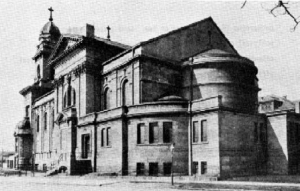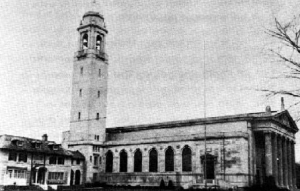Part II: The Irish in Cleveland: One Perspective by Nelson J. Callahan
Chapter 7: Irish in Politics and Professions
The occupations of today’s Irish in Cleveland represent to a great degree the very high premium placed on education by Irish families here from the very beginning. Few of the Irish immigrants to this city were able to rise much higher on the labor and social scale than their meager education in Ireland would take them. But they seemed to know intuitively that a good education for their children was the key to upward mobility. It is interesting to note that the Cleveland Irish community did not produce its first physician until 1887. Today the number of physicians, dentists and nurses, as well as many other practitioners in the field of health care, is remarkably high in comparison with the total Irish population. The same thing can be said for clergy and religious women, although that proportional dominance seems to be shifting as young people of Irish background discover that the advantages of being Irish in the clergy or religious life no longer exist as they once did.
The Influence of Archbishop John Ireland
Perhaps a topic especially intriguing to the non-Irish in Cleveland is the peculiar position occupied by those of Irish background in the practice of law. Some suspect a genuine political conspiracy here, rooted no doubt in the relationship between the Irish in New York active in Tammany Hall and political office, but Cleveland has no Tammany Hall and never did. There are more Irish lawyers and judges than the Irish numbers would warrant. This has been true for much of this century. But unlike Tammany, where the real unifying factor was the Democratic Party, Cleveland’s Irish lawyers, Judges and politicians more likely than not are apt to be Republicans. One can only speculate on this phenomenon. A possible explanation might be found in the politics of the presidential election of 1896. In that year, Archbishop John Ireland of St. Paul, perhaps the most influential bishop of his time, urged all Catholics to abandon the Democratic party candidate, William Jennings Bryan, and to support the Republican William McKinley. He had several reasons for urging this switch in political support.
First, he was convinced that a mindless adherence to any political party by any minority group was to waste the political clout that minority group might have if it challenged each political party to address itself to the needs of that minority group. In this case, he had very much in mind the Irish who had so faithfully voted Democratic in most urban centers of the North, East and Midwest, but who had received no great advantage for doing so.


Second, he believed that if the Irish followed his lead and did actually support the Republican candidate in 1896, the Democrats would lose in national, state and local elections. The result of this election would then influence both parties to seek to woo Irish voters in the election of 1900; thus the Irish would no longer be taken for granted by the one party and ignored by the other, and the Irish would profit from all of this.
It seems that he had in mind especially federal aid to the parochial schools, a problem he had struggled with for nearly 25 years. In 1890 he had established the Fairbault-Stillwater plan for support of the schools. Essentially this was an appeal to the state of Minnesota and the local public school systems of the state to rent and to support the parochial schools in both these towns for $1.00 per year on condition that the Catholic students be given released time during school hours to obtain religious instruction at a site on or near the parochial school property.
The idea was a good one, it would seem. It was a development of a statement Ireland had made in 1890, widely carried in the press, that it was not the building of Catholic schools but their maintenance which would bankrupt the Church in the United States within 100 years (One notes that his prediction still has 15 years to go and yet it is already at least partly true).
But still, Ireland’s solution was a novel one. Catholics were to give up the absolute control of the parochial schools they had built. The curriculum, the accreditation of teaching sisters, the methods of teaching secular subjects and the administrative role of the parish pastor in the school was to be handed over to the state. The parish was to retain control only of religious education. Many Irish pastors in Cleveland, recognizing the validity of Ireland’s prediction, backed him. In doing so they brought politics to the parochial level. Whole parishes turned Republican in their voting, and the descendants of these 1896 voters remain to this day Republican in their voting. One such parish was the Immaculate Conception where the pastor, Cleveland’s second monsignor, Thomas P. Thorpe, influenced whole families to vote Republican, many of whom do so to this day, reinforced by the politics of big business of which they have become a part. One thinks of the late Judge James Connell in particular in this regard.
A further development of this phenomenon of Irish Republican politicians is to be found in the deep-seated Irish fear of any politics that might border on socialism. The Irish had struggled out of poverty and had become convinced of the value of private ownership of land and in some cases, of laissez faire capitalism. For many of them to relinquish their hard won gains to the State was unthinkable. Thus even in the 1950’s, many Cleveland Irish supported Senator Joseph McCarthy in his attacks on Communism, just as many of them had supported Father Coughlin two decades earlier when he broke with Franklin Roosevelt. One might have trouble justifying this seeming conflict with the Irish revolutionary past in Ireland, but it made sense for those who might have forgotten that past. In so doing they became vulnerable to all sorts of demagoguery about which their grandparents might have laughed.
Judge Martin Foran
A different and very special kind of Irish American emerged in politics very early in the history of the Irish immigrant. He was the political independent. In Cleveland his prototype was Martin A. Foran, a member of the Cathedral parish, who ran for Congressman and won, and ultimately became a judge in Cleveland (born in 1844 in Pennsylvania, died in Cleveland in 1921).
He remained a faithful member of the Catholic Church and yet sent his children to the public school; he spurned any overtures of the Cleveland bishops to advocate causes peculiarly Catholic and was branded by Bishop Richard Gilmour, who never grasped Foran’s theory of separation of Church and State, as a rebel. Foran, more than any other 19th Century Cleveland Irish Catholic, moved freely in the world of the Wasps. He was the first Catholic invited to join the Union Club; he was a charter member of the City Club.
But Foran’s independence was at the same time both his credential to the non-Catholic community and his burden with at least some of the Catholic community. His refusal to be dominated by what he considered the arbitrary politics of Bishop Gilmour set him apart from most Irish Catholic politicians who, at least by giving lip service to the bishop, played the game. They thus gained the Catholic vote. The other side of the coin found Foran espousing certain Irish causes without necessarily admitting to the Catholic nature of these causes. This paradox in Foran’s life bewildered Gilmour, who regarded all Irish nationalism independent of the directives of the bishops as subversive. The issue between Gilmour and Foran came to a head In 1887 when Foran declared his support of the Single Tax Theory of Henry George. Dr. Edward McGlynn, Pastor of St. Stephen Church in New York, perhaps the most influential Irish priest in the country at the time, espoused the same cause and indeed campaigned for the election of George in the mayoralty election in New York in 1886. McGlynn was first suspended from his priestly functions in 1886 by Archbishop Michael Corrigan, a close friend of Gilmour, for dabbling in politics. In 1887 McGlynn was excommunicated for his part in the George campaign. He founded the short-lived Anti-Poverty Society in New York after George lost the election and was finally reinstated with the Church by the Apostolic Delegate in 1892.
There were many Irish who followed McGlynn in New York and whose espousal of the George cause came perhaps as close to a schism as the American Church has seen thus far. The reason behind the whole event was the fear of Archbishop Corrigan that the George theory bordered on socialism. This was not the case, really, as the Delegate said in reinstating McGlynn, but in 1891 the conflict did produce Pope Leo XIII’s great Encyclical Rerum Novarum, concerned with the rights of the working man.
But Gilmour’s reaction to Foran was a mirror of Corrigan’s reaction to McGlynn, although Gilmour never went as far as Corrigan in sanctioning Foran. Foran harbored his admiration for the cause of Henry George all the rest of his days. In Cleveland, Foran had the opportunity to support one of George’s truest disciples, Tom Johnson, when Johnson successfully campaigned for mayor of Cleveland through four terms from 1900 to 1908.
It was in the 1900 Johnson campaign that the old political lines which we have noted previously were once and for all broken among the Irish in Cleveland. The divisions remain to this day. Some Irish vote Democrat as they always have, some vote Republican as John Ireland first suggested in 1896, and many, adhering to the concept of a moderate independent which Johnson was, continue to vote for an independent Democrat (sometimes a Republican though less likely). Frank Lausche and Anthony Celebrezze were two such successful mayoral candidates.
The point of all of this is that in Cleveland, politics, especially as they involve the Irish, are unique and they are deeply, though often unconsciously, rooted in the past. There has never been a unified Catholic vote along party lines in Cleveland and surely there has not been a unified Irish vote here since the 1890’s. Machine politics never seem to have gotten off the ground in this city. Those who today do superficial research and who stand outside the history of the Irish in Cleveland suspect at times a clergy-led conspiracy in Cleveland Irish Catholic voting patterns. There is no evidence that would bear this out in the Irish community other than that already noted about some parts of the 19th and early 20th Centuries.
Cleveland’s bishops have failed to understand the politics of the city, and of the Irish, and have sought by the use of power to urge the Irish to vote as though they were Americans with a Wasp background. This tactic simply has never worked. On the contrary, if the local bishops urged a course contrary to the three forms of Irish voting patterns already cited, those patterns were usually intensified. In any case, voting patterns among ethnic groups and especially among the Irish in Cleveland are a subject that is yet to be researched. One suspects that such research would be well worth the effort.
